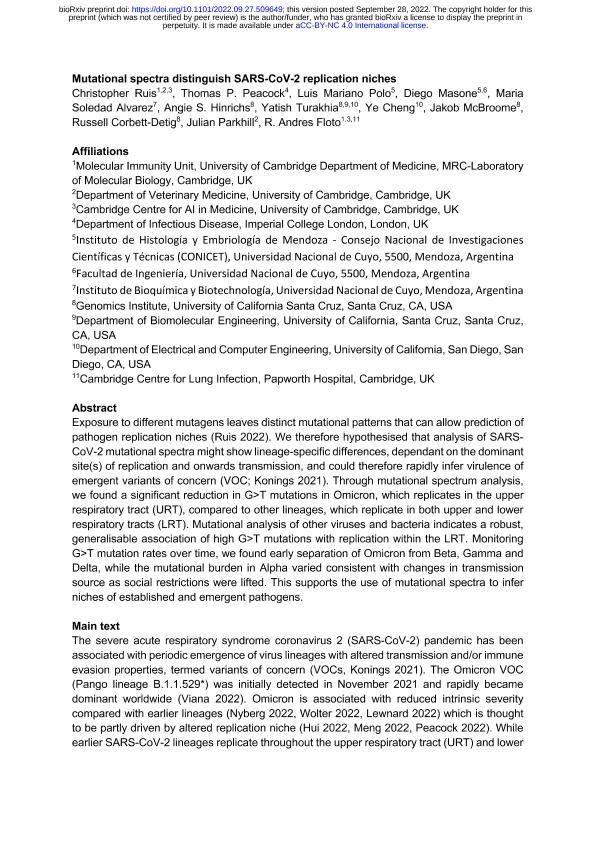Artículo
Mutational spectra distinguish SARS-CoV-2 replication niches
Ruis, Christopher; Peacock, Tomas; Polo Ilacqua, Luis Mariano ; Masone, Diego Fernando
; Masone, Diego Fernando ; Alvarez, Maria Soledad
; Alvarez, Maria Soledad ; Hinrichs, Angie; Turakhia, Yatish; Cheng, Ye; McBroome, Jakob; Corbett Detig, Russell; Parkhill, Julian; Floto, Andrés
; Hinrichs, Angie; Turakhia, Yatish; Cheng, Ye; McBroome, Jakob; Corbett Detig, Russell; Parkhill, Julian; Floto, Andrés
 ; Masone, Diego Fernando
; Masone, Diego Fernando ; Alvarez, Maria Soledad
; Alvarez, Maria Soledad ; Hinrichs, Angie; Turakhia, Yatish; Cheng, Ye; McBroome, Jakob; Corbett Detig, Russell; Parkhill, Julian; Floto, Andrés
; Hinrichs, Angie; Turakhia, Yatish; Cheng, Ye; McBroome, Jakob; Corbett Detig, Russell; Parkhill, Julian; Floto, Andrés
Fecha de publicación:
09/2022
Editorial:
Cold Spring Harbor Laboratory Press
Revista:
bioRxiv
ISSN:
2692-8205
Idioma:
Inglés
Tipo de recurso:
Artículo publicado
Clasificación temática:
Resumen
Exposure to different mutagens leaves distinct mutational patterns that can allow prediction of pathogen replication niches (Ruis 2022). We therefore hypothesised that analysis of SARS-CoV-2 mutational spectra might show lineage-specific differences, dependant on the dominant site(s) of replication and onwards transmission, and could therefore rapidly infer virulence of emergent variants of concern (VOC; Konings 2021). Through mutational spectrum analysis, we found a significant reduction in G>T mutations in Omicron, which replicates in the upper respiratory tract (URT), compared to other lineages, which replicate in both upper and lower respiratory tracts (LRT). Mutational analysis of other viruses and bacteria indicates a robust, generalisable association of high G>T mutations with replication within the LRT. Monitoring G>T mutation rates over time, we found early separation of Omicron from Beta, Gamma and Delta, while the mutational burden in Alpha varied consistent with changes in transmission source as social restrictions were lifted. This supports the use of mutational spectra to infer niches of established and emergent pathogens.
Archivos asociados
Licencia
Identificadores
Colecciones
Articulos(IHEM)
Articulos de INST. HISTOLOGIA Y EMBRIOLOGIA DE MEND DR.M.BURGOS
Articulos de INST. HISTOLOGIA Y EMBRIOLOGIA DE MEND DR.M.BURGOS
Citación
Ruis, Christopher; Peacock, Tomas; Polo Ilacqua, Luis Mariano; Masone, Diego Fernando; Alvarez, Maria Soledad; et al.; Mutational spectra distinguish SARS-CoV-2 replication niches; Cold Spring Harbor Laboratory Press; bioRxiv; 2022; 9-2022; 1-13
Compartir
Altmétricas



